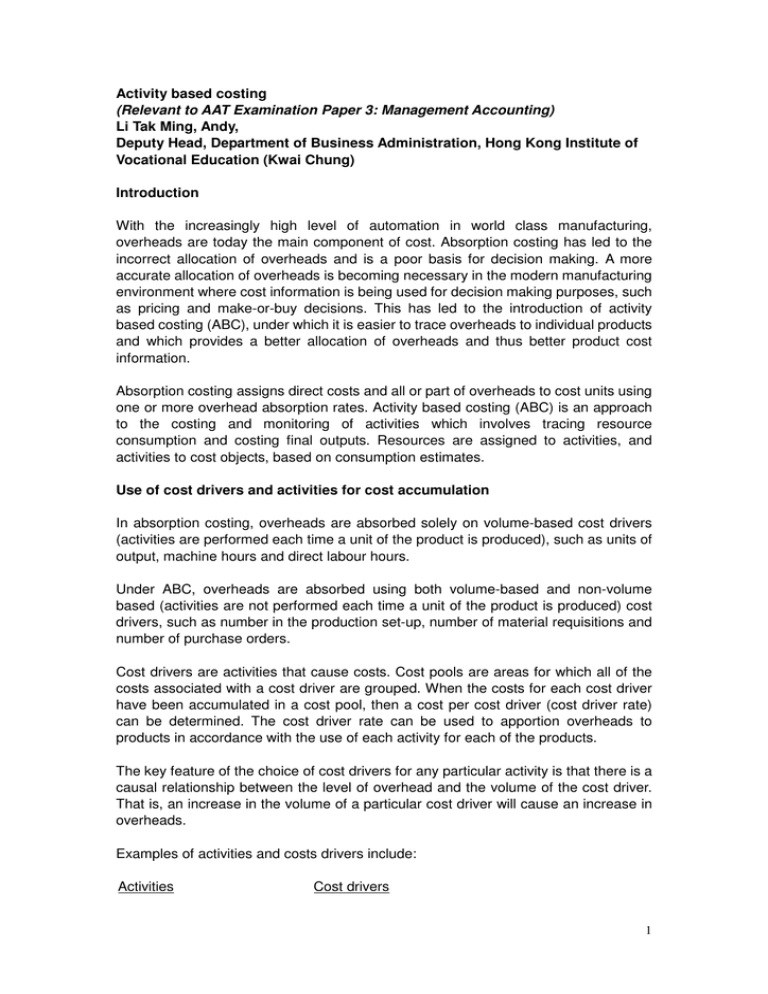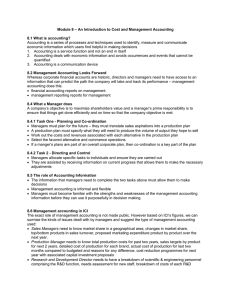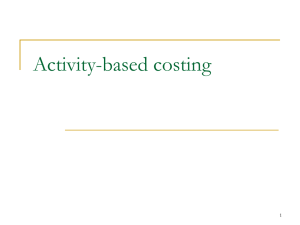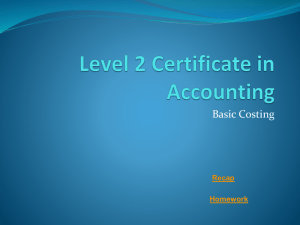Activity based costing Li Tak Ming, Andy,
advertisement

Activity based costing (Relevant to AAT Examination Paper 3: Management Accounting) Li Tak Ming, Andy, Deputy Head, Department of Business Administration, Hong Kong Institute of Vocational Education (Kwai Chung) Introduction With the increasingly high level of automation in world class manufacturing, overheads are today the main component of cost. Absorption costing has led to the incorrect allocation of overheads and is a poor basis for decision making. A more accurate allocation of overheads is becoming necessary in the modern manufacturing environment where cost information is being used for decision making purposes, such as pricing and make-or-buy decisions. This has led to the introduction of activity based costing (ABC), under which it is easier to trace overheads to individual products and which provides a better allocation of overheads and thus better product cost information. Absorption costing assigns direct costs and all or part of overheads to cost units using one or more overhead absorption rates. Activity based costing (ABC) is an approach to the costing and monitoring of activities which involves tracing resource consumption and costing final outputs. Resources are assigned to activities, and activities to cost objects, based on consumption estimates. Use of cost drivers and activities for cost accumulation In absorption costing, overheads are absorbed solely on volume-based cost drivers (activities are performed each time a unit of the product is produced), such as units of output, machine hours and direct labour hours. Under ABC, overheads are absorbed using both volume-based and non-volume based (activities are not performed each time a unit of the product is produced) cost drivers, such as number in the production set-up, number of material requisitions and number of purchase orders. Cost drivers are activities that cause costs. Cost pools are areas for which all of the costs associated with a cost driver are grouped. When the costs for each cost driver have been accumulated in a cost pool, then a cost per cost driver (cost driver rate) can be determined. The cost driver rate can be used to apportion overheads to products in accordance with the use of each activity for each of the products. The key feature of the choice of cost drivers for any particular activity is that there is a causal relationship between the level of overhead and the volume of the cost driver. That is, an increase in the volume of a particular cost driver will cause an increase in overheads. Examples of activities and costs drivers include: Activities Cost drivers 1 Purchase of materials Machining Production set-up Assembly Material handling Number of purchase orders Number of machine hours Number of set-ups Number of labour hours Number of material requisitions Example 1 (AAT Paper 3 Management Accounting, Pilot June 2009, Modified) Jupiter Silverware Products Limited is a leading manufacturer of silver picture frames. The company uses a traditional costing system to allocate production overheads to products using machine hours. The newly appointed financial controller believes that activity based costing can provide a better allocation of production overheads to products than the current system does. The following total production overheads for the last period were recorded by the cost accounting system: Utility costs related to machine hours Production set-up costs Cost of ordering materials Cost of handling materials $ 189,000 120,000 18,000 33,000 Details of the three product models and relevant information for the last period are as follows: Number of production runs Number of material orders Number of material requisitions Units produced Machine hours per unit Direct labour hours per unit ($60 per hour) Direct materials per unit Model 1 17 20 30 1,000 1 0.5 hour $10 Model 2 25 30 100 2,000 1.5 1 hour $12 Model 3 18 40 70 2,500 2 2 hours $15 Required: (a) Calculate the unit production cost of each of the three products using: (i) the traditional absorption costing, and (ii) the activity based costing approach. (b) Comment on your calculations in part (a) above and explain why the activity based costing approach is superior to traditional absorption costing. (a) Using traditional absorption costing: Total machinery hours in the period: 2 Model 1 (1,000 × 1) Model 2 (2,000 × 1.5) Model 3 (2,500 × 2) Hours 1,000 3,000 5,000 9,000 Production overhead absorption rate: $(189,000 + 120,000 + 18,000 + 33,000) ÷ 9,000 = $40 per machine hour Cost summary Per unit: Direct materials Direct labour Prime costs Production overheads ($40 per machine hour) Unit production costs Units produced Total production overheads absorbed Model 1 Model 2 Model 3 $ $ $ 10 12 15 30 60 120 40 72 135 40 60 80 80 132 215 1,000 2,000 2,500 40,000 120,000 200,000 Using activity based costing: Calculation of cost driver rates: Utility costs per machine hour ($189,000 ÷ 9,000) Set-up cost per production run ($120,000 ÷ 60) Cost of ordering per order ($18,000 ÷ 90) Cost of material handling per requisition ($33,000 ÷ 200) $ 21 2,000 200 165 Cost summary Production overheads: Utility costs ($21 per machine hour) Set-up cost ($2,000 per production run) Cost of ordering ($200 per order) Cost of material handling ($165 per requisition) Units produced Per unit: Production overheads Prime costs Production costs Model 1 $ Model 2 $ Model 3 $ 21,000 34,000 4,000 63,000 50,000 6,000 105,000 36,000 8,000 4,950 63,950 16,500 135,500 11,550 160,550 1,000 2,000 2,500 $ 63.95 40.00 103.95 $ 67.75 72.00 139.75 $ 64.22 135.00 199.22 3 (b) Activity based costing (ABC) charges more overheads to lower volume production (Model 1) and charges relatively less to higher volume production (Model 3). The traditional absorption costing approach penalizes high volume products (volume based overhead allocation method). In fact some factory activities are not associated with production volume. The traditional absorption costing approach is used when there is a narrow range of products and overhead costs account for a relatively small proportion of total costs. The nature of some overhead costs has changed in recent years due to higher levels of automation. Production overheads now take up a relatively larger proportion of total costs. ABC recognizes that costs may be analyzed by activities rather than production volume. ABC provides a better allocation of overhead costs in a more precise manner based on a cause-and-effect relationship. References: Yeung Chi Hung, AAT Paper 3 Management Accounting, First Edition 2011, Prentice Hall Colin Drury, Management and Cost Accounting, 7th Edition 2008, South-Western Andy Tak-ming Li & Patrick Kin-wai Ho, BAFS in the New World, Accounting – Elective Part 2 Cost Accounting, First Edition 2010, Pilot Publishing Company Ltd. 4





